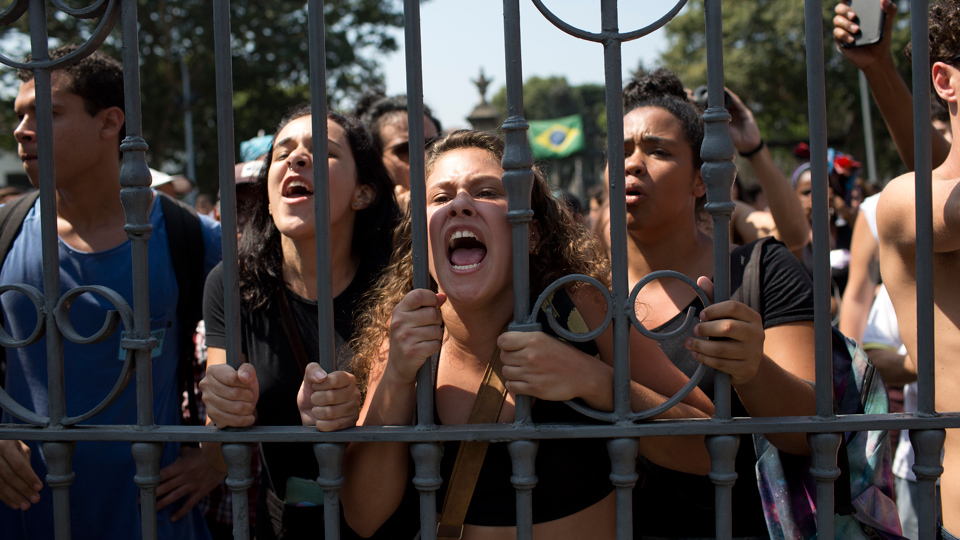
RIO DE JANEIRO (AP) — Smoke rose Monday from the burned-out hulk of Brazil’s National Museum, as recriminations flew over who was responsible for the loss of at least part of Latin America’s largest archive of historical artifacts, objects and documents.
The museum’s director said most of the collection was destroyed but that it was not possible yet to detail what was lost.
Local media were reporting that the blaze destroyed most of the items in the 200-year-old institution.
The museum had a collection of 20 million items — including Egyptian and Greco-Roman artifacts and the oldest human skull found in the Western hemisphere — and was once the home of the Portuguese royal family.
The fire quickly led to criticism over dilapidated infrastructure and budget deficits as Brazilians prepare to vote in national elections in October.
“Just crying doesn’t solve anything,” Alexander Kellner, the museum’s director, told reporters at the scene. He became emotional as he listed the funds and support he said he would now “demand” from authorities to salvage what was left of the collection and rebuild the museum. “We have to act.”
Kellner said that the institution had just recently secured approval for funds for a planned renovation of the museum, including an upgrade of the fire prevention system.
“Look at the irony, the money is now there, but we ran out of time,” he said.
Roberto Robadey, a spokesman for the fire department, said firefighters got off to a slow start fighting the blaze because the two fire hydrants closest to the museum were not functioning. Instead, trucks had to be sent to get water from a nearby lake.
Kellner said there were fire extinguishers on site, but it was not clear if there were sprinklers since they are problematic for museums because water can damage objects.
The walls of the building were still standing Monday, but much of it appeared to have been gutted. Hundreds of people crowded at the gates of the site, many in tears.
On the massive site where the museum sits, the fencing was dilapidated, stonework was cracked and lawns appeared untended.
“This fire is what some Brazilian politicians are doing to the people,” said Rosana Hollanda, a 35-year-old high school teacher, who was crying at the gates of the museum on Monday. “They’re burning our history, and they’re burning our dreams.”
Roberto Leher, the rector of the Federal University of Rio de Janeiro, of which the museum is a part, told reporters Monday that the building needed an upgrade to its electrical and water systems and a new fire prevention plan.
“We all knew the building was in a vulnerable state,” he told reporters. He added that officials had been working with firefighters to reduce those risks.
“A fire of this scale, the reality unfortunately showed this, we needed a systematic intervention,” he said.
Asked by a reporter why such a disaster doesn’t happen at cultural institutions in other countries, Kellner, the museum director, replied: “Ask yourself that. That’s a good question, ask yourself that.”
Latin America’s largest nation has struggled to emerge from its worst recession in decades. The state of Rio de Janeiro has been particularly hard hit in recent years thanks to a combination of falling world prices of oil, one of its major revenue sources, mismanagement and massive corruption.
The museum was closed to the public at the time of the fire, which broke out at 7:30 p.m. Sunday local time, it said in a statement. There were no reports of injuries, the museum said, and it wasn’t immediately clear how the fire began.
A related People’s World article by Emile Schepers points out: “During his first and second terms, from 2003 to 2011, President Luiz Inácio Lula da Silva, a former steelworker, gained great popularity because of economic and social programs that pulled millions of Brazilians out of poverty. He was succeeded by Dilma Rousseff, also of the Workers’ Party. Unfortunately for Rousseff, during her time in office Brazil was hit hard by a sharp economic downturn. Rousseff’s vice president, Michel Temer, took over as president and turned the country sharply to the right, slashing the social safety net and reversing many of the progressive labor laws, and even anti-slavery laws, that had been passed under Lula and Rousseff. Temer himself is one of a huge number of Brazilian politicians who have been enmeshed in the vast “Lava Jato” (“Jiffy Car Wash”) corruption scandal. The result of the Temer presidency has been mass suffering for most Brazilians and severe economic stagnation.”
DiLorenzo reported from Sao Paulo. Associated Press video journalist Yesica Fisch contributed to this report from Rio. AP reporter Mauricio Savarese contributed from Recife, Brazil.










